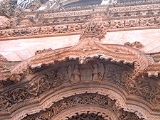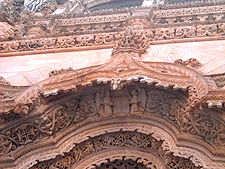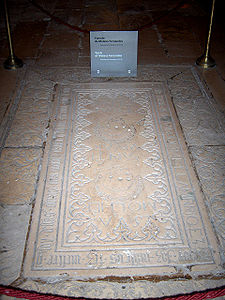
Mateus Fernandes
Encyclopedia
Mateus Fernandes also called Mateus Fernandes the Elder, was a Portuguese architect. He was noted for his works in the Manueline
style at the Monastery of Batalha, Portugal.
 He became master of works at the monastery of Batalha in 1490 or slightly earlier, during the reign of king John II of Portugal
He became master of works at the monastery of Batalha in 1490 or slightly earlier, during the reign of king John II of Portugal
. Before this date, nothing is known of his private life, as he has left no records to consult other than his architectural marvels. He succeeded the architect Fernão de Évora as architect of the monastery. Mateus Fernandes later became the primary architect of the next king, Manuel I of Portugal
, who made him the supervisor of other architectural works in the rest of the country.
However, Mateus Fernandes is best known for his work in "Manueline style" at the entrance portal
of the roofless, Unfinished Chapels (Capelas Imperfeitas) of the Monastery of Batalha. The exceptionally large portal rises to a monumental fifteen meters by 7½ m wide (50 x 25 ft), overshadowing the rest of the chapels at the monastery. It was originally built in Late Gothic style, but was transformed beyond recognition by Fernandes into one of the first masterpieces of Manueline style (completed in 1509). The Manueline style would then spread from Batalha throughout all Portugal.
 The portal is completely decorated into a lacework
The portal is completely decorated into a lacework
of sumptuous Manueline motifs, with flamboyant iconography
including the armillary symbol of the cosmos
, the cross of the Order of Christ
(that decorated the sails of the Portuguese ships of the discoverers), spheres, winged angels, ropes, circles, tree stumps, trefoil
arches and florid projections. Fernandes was again original by making the sculptural aspect dominate over the architectural aspect, united in an asymmetrical composition. Mateus Fernandes has tried to represent in stone, the exuberant and expansive spirit in the reign of king Manuel.
In the homage of King Manuel I to his predecessor, king D. Duarte mentions his motto Leauté faray tam yaserei (I will always be loyal). This motto was then repeated more than two hundred times, carved into the stone arches, vaults
and pillars of the chapels. The original plans for an octagonal dome
, supported by buttresses, to crown this pantheon to the House of Aviz was never to be finished since funds ran out, and the construction of the Jerónimos Monastery
at Belém
would gain absolute priority.
Together with the architect Diogo Boitac, he rendered the Manueline style in the tracery of the arcade
screens in the ambulatory
of the Royal Cloister (Claustro Real) in the Jerónimos Monastery. Fernandes also worked with Boitac to build the abattoirs of Coimbra
in 1511. Boitac was another important Manueline architect and sculptor, who even became the son-in-law of Fernandes by marrying his daughter Isabel Henriques in 1512.
He (or his son, since they carried the same name) is reported to have directed the construction of the church and the hospital of Misericórdia at Óbidos, while they were engaged at the same time in Caldas da Rainha
Mateus Fernandes died in Batalha on 10 April 1515 and was buried, with his wife, under a marble tomb-slab close to the portal of the monastery. Diogo Boitac was buried in a tomb close by in 1528. Fernandes was succeeded as master of works at the monastery in 1516 by his son Mateus Fernandes the Younger (died 1528), who had already been deputized to supervise construction at the monastery in his father’s absence.
Because of East Indian influences in his work and a vague similarity to the design of the Indian Jain temple of Ahmedabad
, scholars have often tried to link Mateus Fernandes to Tomás Fernandes, a military architect in India, or to Diogo Fernandes of Beja
, who was a member of the embassy in Gujarat in 1513. But all this has remained conjecture. The north porch of St Mary Redcliffe
at Bristol
has a resemblance to his style, which is a possibility because of the frequent contacts between Portugal and England.
Manueline
The Manueline, or Portuguese late Gothic, is the sumptuous, composite Portuguese style of architectural ornamentation of the first decades of the 16th century, incorporating maritime elements and representations of the discoveries brought from the voyages of Vasco da Gama and Pedro Álvares Cabral...
style at the Monastery of Batalha, Portugal.

John II of Portugal
John II , the Perfect Prince , was the thirteenth king of Portugal and the Algarves...
. Before this date, nothing is known of his private life, as he has left no records to consult other than his architectural marvels. He succeeded the architect Fernão de Évora as architect of the monastery. Mateus Fernandes later became the primary architect of the next king, Manuel I of Portugal
Manuel I of Portugal
Manuel I , the Fortunate , 14th king of Portugal and the Algarves was the son of Infante Ferdinand, Duke of Viseu, , by his wife, Infanta Beatrice of Portugal...
, who made him the supervisor of other architectural works in the rest of the country.
However, Mateus Fernandes is best known for his work in "Manueline style" at the entrance portal
Portal (architecture)
Portal is a general term describing an opening in the walls of a building, gate or fortification, and especially a grand entrance to an important structure. Doors, metal gates or portcullis in the opening can be used to control entry or exit. The surface surrounding the opening may be made of...
of the roofless, Unfinished Chapels (Capelas Imperfeitas) of the Monastery of Batalha. The exceptionally large portal rises to a monumental fifteen meters by 7½ m wide (50 x 25 ft), overshadowing the rest of the chapels at the monastery. It was originally built in Late Gothic style, but was transformed beyond recognition by Fernandes into one of the first masterpieces of Manueline style (completed in 1509). The Manueline style would then spread from Batalha throughout all Portugal.

Lacework
Pag lace is a type of lacework from Pag on the island of Pag, requires a needle, thread and backing which is a round or square hard stuffed pillow....
of sumptuous Manueline motifs, with flamboyant iconography
Iconography
Iconography is the branch of art history which studies the identification, description, and the interpretation of the content of images. The word iconography literally means "image writing", and comes from the Greek "image" and "to write". A secondary meaning is the painting of icons in the...
including the armillary symbol of the cosmos
Cosmos
In the general sense, a cosmos is an orderly or harmonious system. It originates from the Greek term κόσμος , meaning "order" or "ornament" and is antithetical to the concept of chaos. Today, the word is generally used as a synonym of the word Universe . The word cosmos originates from the same root...
, the cross of the Order of Christ
Order of Christ
Order of Christ may refer to:* Order of Christ – former Knights Templar Order awarded initially by the kings of Portugal, now by the Portuguese state...
(that decorated the sails of the Portuguese ships of the discoverers), spheres, winged angels, ropes, circles, tree stumps, trefoil
Trefoil
Trefoil is a graphic form composed of the outline of three overlapping rings used in architecture and Christian symbolism...
arches and florid projections. Fernandes was again original by making the sculptural aspect dominate over the architectural aspect, united in an asymmetrical composition. Mateus Fernandes has tried to represent in stone, the exuberant and expansive spirit in the reign of king Manuel.
In the homage of King Manuel I to his predecessor, king D. Duarte mentions his motto Leauté faray tam yaserei (I will always be loyal). This motto was then repeated more than two hundred times, carved into the stone arches, vaults
Vault (architecture)
A Vault is an architectural term for an arched form used to provide a space with a ceiling or roof. The parts of a vault exert lateral thrust that require a counter resistance. When vaults are built underground, the ground gives all the resistance required...
and pillars of the chapels. The original plans for an octagonal dome
Dome
A dome is a structural element of architecture that resembles the hollow upper half of a sphere. Dome structures made of various materials have a long architectural lineage extending into prehistory....
, supported by buttresses, to crown this pantheon to the House of Aviz was never to be finished since funds ran out, and the construction of the Jerónimos Monastery
Jerónimos Monastery
The Hieronymites Monastery is located near the shore of the parish of Belém, in the municipality of Lisbon, Portugal...
at Belém
Santa Maria de Belém
Santa Maria de Belém, or just Belém , whose name is derived from the Portuguese word for Bethlehem, is a civil parish of the municipality of Lisbon, in central Portugal...
would gain absolute priority.
Together with the architect Diogo Boitac, he rendered the Manueline style in the tracery of the arcade
Arcade (architecture)
An arcade is a succession of arches, each counterthrusting the next, supported by columns or piers or a covered walk enclosed by a line of such arches on one or both sides. In warmer or wet climates, exterior arcades provide shelter for pedestrians....
screens in the ambulatory
Ambulatory
The ambulatory is the covered passage around a cloister. The term is sometimes applied to the procession way around the east end of a cathedral or large church and behind the high altar....
of the Royal Cloister (Claustro Real) in the Jerónimos Monastery. Fernandes also worked with Boitac to build the abattoirs of Coimbra
Coimbra
Coimbra is a city in the municipality of Coimbra in Portugal. Although it served as the nation's capital during the High Middle Ages, it is better-known for its university, the University of Coimbra, which is one of the oldest in Europe and the oldest academic institution in the...
in 1511. Boitac was another important Manueline architect and sculptor, who even became the son-in-law of Fernandes by marrying his daughter Isabel Henriques in 1512.
He (or his son, since they carried the same name) is reported to have directed the construction of the church and the hospital of Misericórdia at Óbidos, while they were engaged at the same time in Caldas da Rainha
Caldas da Rainha
Caldas da Rainha is a city in western central Portugal. The city serves as the seat of the larger municipality of the same name and is the seat of the Comunidade Intermunicipal do Oeste...
Mateus Fernandes died in Batalha on 10 April 1515 and was buried, with his wife, under a marble tomb-slab close to the portal of the monastery. Diogo Boitac was buried in a tomb close by in 1528. Fernandes was succeeded as master of works at the monastery in 1516 by his son Mateus Fernandes the Younger (died 1528), who had already been deputized to supervise construction at the monastery in his father’s absence.
Because of East Indian influences in his work and a vague similarity to the design of the Indian Jain temple of Ahmedabad
Ahmedabad
Ahmedabad also known as Karnavati is the largest city in Gujarat, India. It is the former capital of Gujarat and is also the judicial capital of Gujarat as the Gujarat High Court has its seat in Ahmedabad...
, scholars have often tried to link Mateus Fernandes to Tomás Fernandes, a military architect in India, or to Diogo Fernandes of Beja
Beja (Portugal)
Beja is a city in the Beja Municipality in the Alentejo region, Portugal. The municipality has a total area of 1,147.1 km² and a total population of 34,970 inhabitants. The city proper has a population of 21,658....
, who was a member of the embassy in Gujarat in 1513. But all this has remained conjecture. The north porch of St Mary Redcliffe
St Mary Redcliffe
St. Mary Redcliffe is an Anglican parish church located in the Redcliffe district of the English port city of Bristol, close to the city centre. Constructed from the 12th to the 15th centuries, the church is a Grade 1 listed building, St...
at Bristol
Bristol
Bristol is a city, unitary authority area and ceremonial county in South West England, with an estimated population of 433,100 for the unitary authority in 2009, and a surrounding Larger Urban Zone with an estimated 1,070,000 residents in 2007...
has a resemblance to his style, which is a possibility because of the frequent contacts between Portugal and England.

